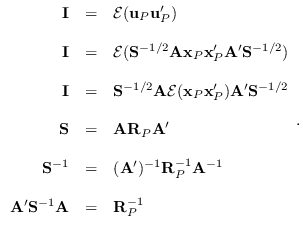Next: AR data PDF, Large Up: AR modeling Previous: AR modeling Contents
r = rlevinson([a(:); zeros(N-P-1,1)],sig2);In practice, we would obtain the length-
In the following analysis, we assume that the AR coefficients are known. The problem
of computing (10.6) knowing just ![]() is inherently different
because we must estimate the AR coefficients (See sections 10.4.3).
Efficient means of computing the exact PDF for the more general ARMA model
are provided in Sections 10.2.2 and 10.2.3.
The special properties of the AR model can be used to advantage.
First of all,
is inherently different
because we must estimate the AR coefficients (See sections 10.4.3).
Efficient means of computing the exact PDF for the more general ARMA model
are provided in Sections 10.2.2 and 10.2.3.
The special properties of the AR model can be used to advantage.
First of all, ![]() , the impulse response length of the whitening filter
is exactly
, the impulse response length of the whitening filter
is exactly ![]() . Thus, only the first
. Thus, only the first ![]() samples
of the whitened sequence need be “corrected".
samples
of the whitened sequence need be “corrected".
Also, a closed form expression for the inverse of the ![]() ACF matrix
can be found.
Suppose we obtain the AR coeffients of all orders up to and including
ACF matrix
can be found.
Suppose we obtain the AR coeffients of all orders up to and including ![]() .
Let r(i) be the i-th ACF coefficient (lag i-1).
Let Aa(p,:) be the
.
Let r(i) be the i-th ACF coefficient (lag i-1).
Let Aa(p,:) be the ![]() -th order AR coefficient vector
and e(p) the corresponding prediction error variance
-th order AR coefficient vector
and e(p) the corresponding prediction error variance
![]() (note that
(note that
![]() ) :
) :
Aa = zeros(P+1,P+1);
for p=1:P+1,
[Aa(p,1:p),e(p)]=levinson(r(1:p));
end;
Now consider the operation :
u(1) = (x(1)*Aa(1,1))/sqrt(e(1)); u(2) = (x(2)*Aa(2,1) + x(1)*Aa(2,2))/sqrt(e(2)); : : u(P) = (x(P)*Aa(P,1) + ... + x(1)*Aa(P,P))/sqrt(e(P)); u(P+1) = (x(P+1)*Aa(P+1,1) + ... + x(1)*Aa(P+1,P+1))/sqrt(e(P+1)); u(P+2) = (x(P+2)*Aa(P+1,1) + ... + x(2)*Aa(P+1,P+1))/sqrt(e(P+1)); u(P+3) = (x(P+3)*Aa(P+1,1) + ... + x(3)*Aa(P+1,P+1))/sqrt(e(P+1)); : :Notice that above index
![$\displaystyle {\bf A} = \left[ \begin{array}{cccccc}
1&0&0&0&0&0\\
{\tt Aa}(2,...
...6)&{\tt Aa}(6,5)&{\tt Aa}(6,4)&{\tt Aa}(6,3)&{\tt Aa}(6,2)&1
\end{array}\right]$](img1228.png) |
(10.43) |

So, to obtain an efficient means of computing the exact PDF of ![]() for an AR process,
which will have execution time of order
for an AR process,
which will have execution time of order ![]() , we can use:
, we can use:
u = filter(a,1,x)/sqrt(sig2);Then, repace u(1:P) with the result of (10.42) on just the first
ldetR = sum(log(e(1:P))) + (N-P)*log(e(P+1));For details, see software/pdf_ar_exact.m, or the more general function software/pdf_arma_exact.m.
Rp=toeplitz(rb(1:imax)) C = chol(Rp);What is the relationship between C and A? How can the filtering operation above be written in terms of C?